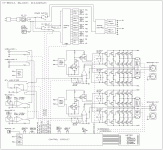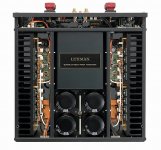Yes, I remember that at one time you thought about selleing the second CLT1.
Anyway, I haven't seen the schematics, but I am very impressed with a tube unit the size of a full 19 inch rack that measures 30kHz harmonics down to -150dB. I'm not sure there is any equipment on the market today that does this. Some thing of a trend; if you look at AP, the newer units have less dynamic range than the original S1 and S2.
jan didden
Except that the CLT-1 is all solid state. its full of separate circuit boards in modules. Even the meter, which has no circuitry, has a board and a module to plug into the frame. I have the schematics courtesy of the Japanese distributor and can provide them if anyone is interested. Don't even think about building one from scratch. The magnetics are the hard part. I usually get -165 to -170 dB for the 3rd harmonic. The newer CLT-10 has some changes that limit the absolute performance possibly but its faster and has all the corrections done automatically.
I have used Metcal's for years. I have a power meter on the one I used daily. The lower frequency version has been around for a long time. it works OK but isn't as clean as the 27 MHz versions. There is some RF leakage that clutters my bench. I have a gadget I got long ago for the Metcal that senses the tip in the holder and cycles the iron at an adjustable rate. After 10 minutes of inactivity it shuts down until you pick up the iron.
The tip uses the same Curie point sensing that the Weller does, but heats with an induction coil in the tip. That's why its so responsive. They also have quite a few specialty tips for difficult stuff. I seem to get several years of hard bench development work out of a $25 tip. But I buy on eBay, or I will have until all the readers here sucked them all up. (Thanks, Charles)
The tip uses the same Curie point sensing that the Weller does, but heats with an induction coil in the tip. That's why its so responsive. They also have quite a few specialty tips for difficult stuff. I seem to get several years of hard bench development work out of a $25 tip. But I buy on eBay, or I will have until all the readers here sucked them all up. (Thanks, Charles)
Demian, I am still trying to fix the power supply of the QuanTech you gave me (can't gripe too much '-) Searched high and low for a Ge T0-3 power transistor. I actually found one! We shall see tomorrow, if Brian shows up here. Just in case, do you have any available, if mine doesn't work out?
Hi Demian,
That sounds like a really cool instrument. I wouldn't mind a copy of the schematics. No, I haven't the time to build one, never mind the magnetic components issue!
Sent you a message.
Hi John,
What part number do you need? I have some NOS parts and may just have one. Delco or Jedec?
-Chris
That sounds like a really cool instrument. I wouldn't mind a copy of the schematics. No, I haven't the time to build one, never mind the magnetic components issue!
Sent you a message.
Hi John,
What part number do you need? I have some NOS parts and may just have one. Delco or Jedec?
-Chris
Demian, I am still trying to fix the power supply of the QuanTech you gave me (can't gripe too much '-) Searched high and low for a Ge T0-3 power transistor. I actually found one! We shall see tomorrow, if Brian shows up here. Just in case, do you have any available, if mine doesn't work out?
I have another QT IC analyzer with most of the same stuff in it. We can arrange for you to use it for board swapping if necessary. I'll review with Brian.
Thanks Demian, Brian and I have already checked the board parts, now it is the power transistor on the case of the meter bay. So, perhaps Brian and I will try to fix, tomorrow. You know if the transistor looks like a short, it probably is shorted! '-)
> The tip uses the same Curie point sensing that the Weller does, but heats with an induction coil in the tip. That's why its so responsive.
That means the temperature is not adjustable, or how ?
Patrick
That means the temperature is not adjustable, or how ?
Patrick
> The tip uses the same Curie point sensing that the Weller does, but heats with an induction coil in the tip. That's why its so responsive.
That means the temperature is not adjustable, or how ?
Patrick
Different tips. It can add up if you get a lot at once. I have 2 or three that see much use. It can't overheat because the inductance goes away at the target temperature.
Same tip geometry but different temperatures ?
That means a lot of tips if you want a couple of tip form as well .....
Patrick
That means a lot of tips if you want a couple of tip form as well .....
Patrick
Except that the CLT-1 is all solid state.[snip]
Really? Never realised that.
jan didden
M800
ƒ‰ƒbƒNƒXƒ}ƒ“Š”Ž®‰ïŽÐ�bƒz�[ƒ€�»•i�î•ñ�bƒXƒeƒŒƒIƒpƒ��[ƒAƒ“ƒvM-800A - LUXMAN
Only the pics I can understand....
Regards, Loek
And I would also be curious to see the schematic.
ƒ‰ƒbƒNƒXƒ}ƒ“Š”Ž®‰ïŽÐ�bƒz�[ƒ€�»•i�î•ñ�bƒXƒeƒŒƒIƒpƒ��[ƒAƒ“ƒvM-800A - LUXMAN
Only the pics I can understand....
Regards, Loek
Attachments
Last edited:
Hi Ladies and Germans,
Although I'm still working my way through the 13000+ posts in Part Deux, I wonder if it's appropriate to present a circuit element derived from the famous John Curl "boxer" input stage. The circuit is a "boxer" second stage ("VAS" in op-amp speak) with its advantages, although I'm using a half circuit version for a phono equalizer.
If interested, let me know, or if OT, also let me know. I've enjoyed these two threads enormously, and much, much thanks to all.
Chris
Although I'm still working my way through the 13000+ posts in Part Deux, I wonder if it's appropriate to present a circuit element derived from the famous John Curl "boxer" input stage. The circuit is a "boxer" second stage ("VAS" in op-amp speak) with its advantages, although I'm using a half circuit version for a phono equalizer.
If interested, let me know, or if OT, also let me know. I've enjoyed these two threads enormously, and much, much thanks to all.
Chris
I bet they are National.
Nope , toshiba custom SIP . Same as the JVC super A , custom manufactured for luxman. A good way to keep the IP secret ... put it in a proprietary IC. 🙁
OS
John,
The Design is the same "Only Distortion Feedback" as the B1000.
MJ had pretty extensive articles on this. The "Op-Amp" shown is actually no op-amp, but a discrete ciruit.
The "forward" path of the Amp is a simple single ended 2-stage open loop BJT Circuit, driving one side of the output stage with high impedance.
The "Op-Amp" only receives the extracted error, amplifies it suitably and applies it to the other side of the output stage.
Both "Distortion feedback" and "Signal" are mixed at the input of the output stage.
I personally would suggest that contrary to OSTrippers comments the design is quite unusual and interesting. I can see the possibility for it to provide better tradeoffs between "zero feedback" and "ton's of feedback" without attracting the undesirable side-effects of either...
Ciao T
So far, so good, but the 'essence is in the 'triangles'.
The Design is the same "Only Distortion Feedback" as the B1000.
MJ had pretty extensive articles on this. The "Op-Amp" shown is actually no op-amp, but a discrete ciruit.
The "forward" path of the Amp is a simple single ended 2-stage open loop BJT Circuit, driving one side of the output stage with high impedance.
The "Op-Amp" only receives the extracted error, amplifies it suitably and applies it to the other side of the output stage.
Both "Distortion feedback" and "Signal" are mixed at the input of the output stage.
I personally would suggest that contrary to OSTrippers comments the design is quite unusual and interesting. I can see the possibility for it to provide better tradeoffs between "zero feedback" and "ton's of feedback" without attracting the undesirable side-effects of either...
Ciao T
- Status
- Not open for further replies.
- Home
- Member Areas
- The Lounge
- John Curl's Blowtorch preamplifier part II


